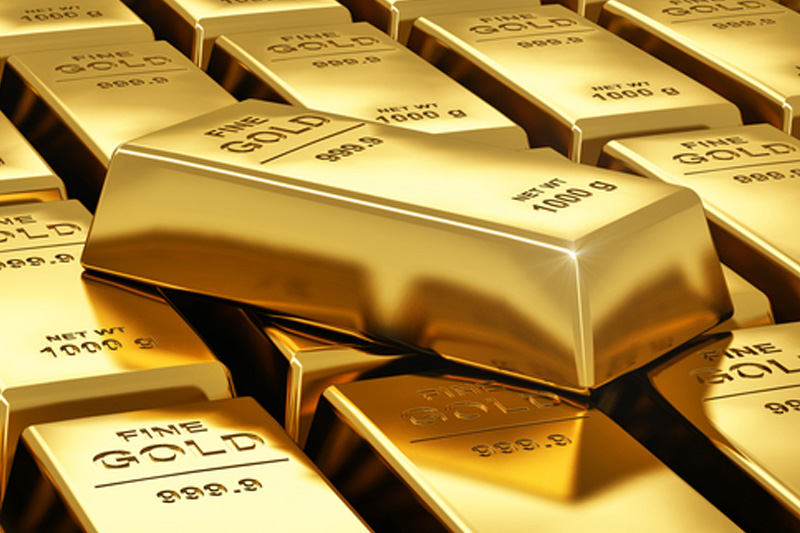Investing.com - Gold traded near a four-month high on Monday, as investors looked ahead to Thursday's meeting of the European Central Bank, amid speculation it will launch a government bond-buying program.
On the Comex division of the New York Mercantile Exchange, gold futures for February delivery dipped $1.30, or 0.1%, to trade at $1,275.60 a troy ounce during European morning hours.
Prices held in a tight range between $1,274.90 and $1,281.90. Trade volumes were expected to remain light on Monday, with U.S. markets closed for a holiday.
On Friday, gold hit $1,282.40, the most since September 2, before settling at $1,276.90, up $12.10, or 0.96%.
Futures were likely to find support at $1,255.20, the low from January 16, and resistance at $1,290.90, the high from September 2.
Also on the Comex, silver futures for March delivery shed 7.2 cents, or 0.41%, to trade at $17.67 a troy ounce.
The euro was close to recent lows against the dollar and the yen on Monday as investors waited to see if the European Central Bank would embark on an outright quantitative easing program on Thursday.
Last Thursday, the Swiss National Bank abandoned its three-year old 1.20 per euro exchange rate cap in a shock move, signaling that it expects the ECB to act this week.
The move roiled financial markets and saw the Swiss franc strengthen across the board.
The U.S. dollar index, which measures the greenback’s strength against a trade-weighted basket of six major currencies, dipped 0.35% to 92.72.
Elsewhere in metals trading, copper for March delivery declined 1.1 cents, or 0.42%, to trade at $2.607 a pound.
Market participants looked ahead to a raft of Chinese economic data due on Tuesday for further indications on the strength of the economy and the future path of monetary policy.
The Asian nation will release data on fourth quarter gross domestic product, as well as reports on industrial production, retail sales and fixed-asset investment for December.
Market analysts expect China's economy to grow 7.2% in the three months ending December 31, down from growth of 7.3% in the preceding quarter.
Recent economic data from the Asian nation has indicated that the recovery remains fragile and may require further monetary stimulus.
China is the world’s largest copper consumer, accounting for almost 40% of world consumption.
- English (UK)
- English (India)
- English (Canada)
- English (Australia)
- English (South Africa)
- English (Philippines)
- English (Nigeria)
- Deutsch
- Español (España)
- Español (México)
- Français
- Italiano
- Nederlands
- Português (Portugal)
- Polski
- Português (Brasil)
- Русский
- Türkçe
- العربية
- Ελληνικά
- Svenska
- Suomi
- עברית
- 日本語
- 한국어
- 简体中文
- 繁體中文
- Bahasa Indonesia
- Bahasa Melayu
- ไทย
- Tiếng Việt
- हिंदी
Gold trades near 4-month high; ECB meeting eyed

Latest comments
Install Our App
Risk Disclosure: Trading in financial instruments and/or cryptocurrencies involves high risks including the risk of losing some, or all, of your investment amount, and may not be suitable for all investors. Prices of cryptocurrencies are extremely volatile and may be affected by external factors such as financial, regulatory or political events. Trading on margin increases the financial risks.
Before deciding to trade in financial instrument or cryptocurrencies you should be fully informed of the risks and costs associated with trading the financial markets, carefully consider your investment objectives, level of experience, and risk appetite, and seek professional advice where needed.
Fusion Media would like to remind you that the data contained in this website is not necessarily real-time nor accurate. The data and prices on the website are not necessarily provided by any market or exchange, but may be provided by market makers, and so prices may not be accurate and may differ from the actual price at any given market, meaning prices are indicative and not appropriate for trading purposes. Fusion Media and any provider of the data contained in this website will not accept liability for any loss or damage as a result of your trading, or your reliance on the information contained within this website.
It is prohibited to use, store, reproduce, display, modify, transmit or distribute the data contained in this website without the explicit prior written permission of Fusion Media and/or the data provider. All intellectual property rights are reserved by the providers and/or the exchange providing the data contained in this website.
Fusion Media may be compensated by the advertisers that appear on the website, based on your interaction with the advertisements or advertisers.
Before deciding to trade in financial instrument or cryptocurrencies you should be fully informed of the risks and costs associated with trading the financial markets, carefully consider your investment objectives, level of experience, and risk appetite, and seek professional advice where needed.
Fusion Media would like to remind you that the data contained in this website is not necessarily real-time nor accurate. The data and prices on the website are not necessarily provided by any market or exchange, but may be provided by market makers, and so prices may not be accurate and may differ from the actual price at any given market, meaning prices are indicative and not appropriate for trading purposes. Fusion Media and any provider of the data contained in this website will not accept liability for any loss or damage as a result of your trading, or your reliance on the information contained within this website.
It is prohibited to use, store, reproduce, display, modify, transmit or distribute the data contained in this website without the explicit prior written permission of Fusion Media and/or the data provider. All intellectual property rights are reserved by the providers and/or the exchange providing the data contained in this website.
Fusion Media may be compensated by the advertisers that appear on the website, based on your interaction with the advertisements or advertisers.
© 2007-2025 - Fusion Media Limited. All Rights Reserved.